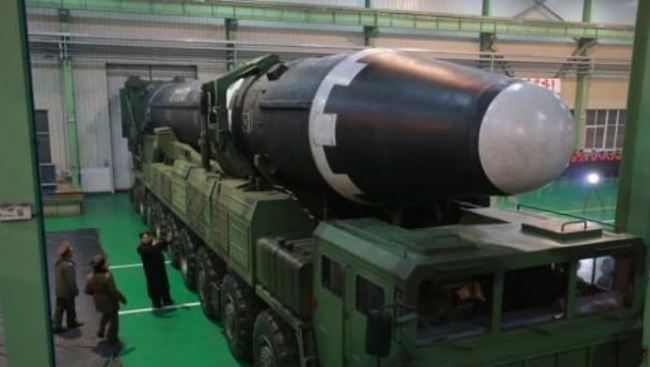Defense ministry: Hwasong-15 could reach Washington D.C.
By Korea HeraldPublished : Dec. 1, 2017 - 17:03
South Korea’s Defense Ministry said Friday that the North Korean missile launched two days earlier was a new type of missile that can fly more than 13,000 kilometers.
“It is assessed that the test flight was successful, and the ICBM could have flown more than 13,000 kilometers if it were fired at a normal angle,” the ministry said in a report to the parliamentary committee on national defense.
“This means it could reach Washington DC.”
“It is assessed that the test flight was successful, and the ICBM could have flown more than 13,000 kilometers if it were fired at a normal angle,” the ministry said in a report to the parliamentary committee on national defense.
“This means it could reach Washington DC.”

North Korea fired a ballistic missile eastward from a site about 30 kilometers north of Pyongyang at around 3:17 am on Nov. 29, according to the ministry. It reportedly traveled 950 kilometers at a maximum altitude of 4,475 kilometers before falling into the East Sea.
The fact that the ministry officially recognized the capability of a North Korean ICBM to hit Washington DC is likely to lead to a major revision of the 4D Concept, an operational guideline to counter nuclear and missile threats from North Korea in four stages -- Detect, Disrupt, Destroy and Defense.
South Korea and the United States adopted the 4D Concept in their annual Security Consultative Meeting in November 2015. The operational concept was first applied during the allies’ Key Resolve joint exercise in March last year.
The US government is expected to analyze the possible flight routes of the Hwasong-15 from various angles, build an operational concept to intercept it from the ground, and simulate it during the joint military drills with South Korea.
The South’s Defense Ministry said, however, that more needs to be verified on the missile’s atmospheric reentry, final-phase precision guidance technologies and warhead conditions.
Based on its analysis of photos released by the North on Wednesday, the ministry said the Hwasong-15 was two meters longer and 0.4-0.8 meter wider in diameter than the previous model, the Hwasong-14.
The new missile’s transporter erector launcher (TEL) had nine wheels on each side, while the Hwasong-14 had a 16-wheel TEL.
The first stage of the Hwasong-15 used a cluster of two Hwasong-14 engines, and analysis of the second-stage engine is underway, added the ministry.
“The body size of the second stage has increased three or four times compared to the Hwasong-14,” it said.
President Moon Jae-in also said that North Korea’s claim that it has secured the technology to miniaturize nuclear warheads and allow an ICBM to re-enter the earth’s atmosphere was yet to be verified.
During an hourlong telephone conversation late Thursday, Moon told US President Donald Trump that it was not clear whether North Korea’s ICBM development reached completion as it claimed.
“The missile launched yesterday certainly was the most advanced one so far in all aspects, but the reentry technology has not yet been proven, and it is also uncertain whether the North has secured the technology to miniaturize nuclear warheads,” he told the US president, according to Cheong Wa Dae spokesman Park Soo-hyun.
“The task we face is to completely prevent North Korea from further advancing its nuclear and missile technologies, and eventually to have them dismantled,” Moon added.
Moon and Trump agreed during their longest telephone conversation so far to continue strong pressure and sanctions against the North until it voluntarily gives up developing nukes and missiles, and comes out for dialogue, Cheong Wa Dae said.
“President Trump underscored the need to deter provocations and counter threats from North Korea with overwhelming power based on the strong joint defense posture of South Korea and the United States,” Park said in the press release.
The US leader also reaffirmed his support for South Korea’s efforts to enhance its defense capabilities through acquiring advanced military assets of the United States, according to Park.
By Kim So-hyun (sophie@heraldcorp.com)
-
Articles by Korea Herald







![[Graphic News] More Koreans say they plan long-distance trips this year](http://res.heraldm.com/phpwas/restmb_idxmake.php?idx=644&simg=/content/image/2024/04/17/20240417050828_0.gif&u=)
![[KH Explains] Hyundai's full hybrid edge to pay off amid slow transition to pure EVs](http://res.heraldm.com/phpwas/restmb_idxmake.php?idx=644&simg=/content/image/2024/04/18/20240418050645_0.jpg&u=20240419100350)






![[From the Scene] Monks, Buddhists hail return of remains of Buddhas](http://res.heraldm.com/phpwas/restmb_idxmake.php?idx=652&simg=/content/image/2024/04/19/20240419050617_0.jpg&u=20240419175937)

![[KH Explains] Hyundai's full hybrid edge to pay off amid slow transition to pure EVs](http://res.heraldm.com/phpwas/restmb_idxmake.php?idx=652&simg=/content/image/2024/04/18/20240418050645_0.jpg&u=20240419100350)

![[Today’s K-pop] Illit drops debut single remix](http://res.heraldm.com/phpwas/restmb_idxmake.php?idx=642&simg=/content/image/2024/04/19/20240419050612_0.jpg&u=)